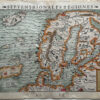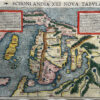Abraham Ortelius (1527 – 1598)
Abraham Ortelius was a Flemish/Dutch mapmaker and is perhaps the best known and most frequently collected of all sixteenth-century mapmakers. He was born in Antwerp which was then in the Habsburg Netherlands (now Belgium). The „Ortellius family“ was originally from Augsburg/Germany, a Free Imperial City of the Holy Roman Empire. Abraham started his career as a map engraver. In 1547 he entered the Antverp guild of Saint Luke as „afsetter van Karten“ (illuminator of maps) and became a business man dealing with books, prints and maps. He travelled a lot and at the Frankfurt book and print fair he met Gerardus Mercator in 1554. Due to his influence Ortelius seems to have been attracted towards the career of a scientific geographer. In 1564 Ortelius published his first map „Typus Orbis Terrarum“, an eight-leaved wall map of the world and in 1570 the Atlas „Theatrum Orbis Terrarum“ (Theatre of the World) with 53 maps.
„The publication of this atlas marked an epoch in the history of cartography. It was the first uniformly sized, systematic collection of maps of the countries of the world based on contemporary knowledge and in that sense may be called the first modern atlas“ (Tooley, Maps and Mapmakers). In 1573 Ortelius started editing supplementary maps under the title „Additamentum Theatri Orbis Terrarum“. In 1575 he was appointed geographer to the King of Spain, Philipp II.
By the time of his death in 1598, a total of 25 editions were published including editions in Latin, Italian, German, French and Dutch; later editions were issued in Spanish and English by Ortelius‘ successors Galle and Vrients. Over the decades the atlas has tripled in size. The final edition was issued in 1612.
Also remarkable about Ortelius is that he has been the first to underline a similarity between the coasts of America and Europe-Africa and to propose a continental drift as an explanation.
Abraham Ortelius is often considered as the father of the Golden Age of the Dutch cartography. His death and burial in the St. Michael‘s Abbey in Antwerp were marked by public mourning. The inscription on his tombstone reads: „Quietis cultor sine lite, uxore, prole“ (Served quietly, without accusation, wife and offspring).
Map details
This map is from Ortelius‘ miniature atlas „Epitome Theatri Orteliani“ which was first
introduced in Antwerp 1585 as a „pocket“ version of „Theatrum Orbis Terrarum“. His friends Philip Galle, the engraver, and Pieter Heyns, the poet, are traditionally credited with the initiative for this reduced format atlas. The atlas was published by varying printers and engravers through the 18th century. In 1598, a pirate edition was published by Pietro Maria Marchetti (No. 112), with more editions in the following decades.
This map from a c. 1598 version is framed by text in Italian language and has three titles: „Europa. Scandia“ is written on top outside the neatline, “Septentionales Regiones“ underneath and „Septentrionalium regionum descriptio“ in a rectangle in the lower right corner.
The map covers the area between „America pars“ in the west („Occidens“) and „Russia Pars“ in the east („Oriens“). It is decorated with a sailing vessel and a distance scale with circle in the lower left corner. There is a big land in the far North which looks like a peninsula named „Septentrio“ (North) but there is none in reality. Even more mysterious is the text „Pigmei hio habitant“ (Pygmies live here).
The map also shows the British Isles, Scandinavia, the Baltic region and the northern part of Germany. The Faroe Islands are missing but two fantasy islands are illustrated, one is named „FRI-ISLAND“ (Frisland), one is anonymous. „Thulios“ is written into the dotted area east of „America Pars“.
„Islant“ is printed across the depiction of the island. Only two church symbols without names are to be seen, surprisingly less than in Greenland.
A comparison between this map (No. 151) of c.1598 and the Sarzina map (No. 149) of 1623 shows that the sections of the image, the geographical shapes and the location names are very similar. However this map is more decorative.



